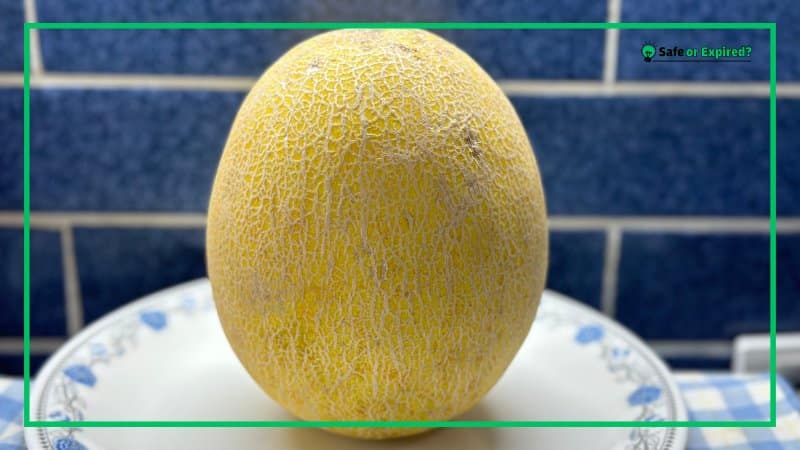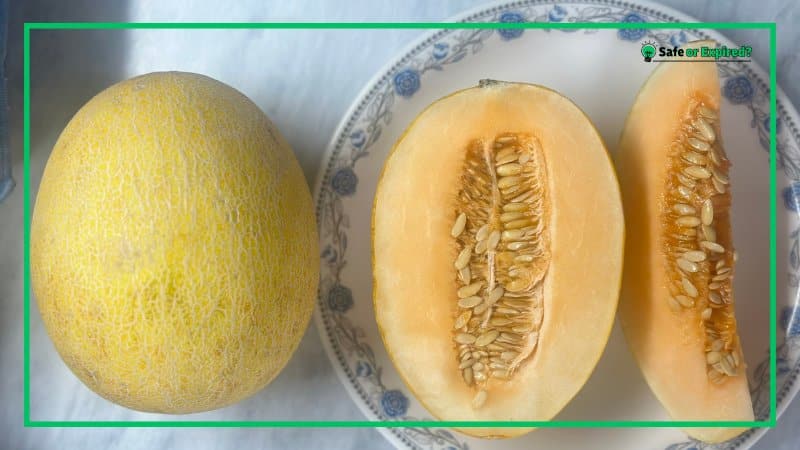“How long does cantaloupe last? is a common question for fruit lovers wanting to enjoy peak freshness. Typically, a whole cantaloupe stays fresh for about 5 to 14 days, depending on where you keep it.
Worry not; I’m discussing all the best methods to keep your cantaloupe deliciously fresh. Keep reading to know the secrets of extending the life of your favorite melon.
How Long Does Cantaloupe Last?
Whole cantaloupes can stay fresh for about a week at room temperature. If you pop them in the fridge, they can last up to two weeks. Once you cut them, you should eat them within three to four days to enjoy their best taste and texture.
These are the factors that influence cantaloupe’s shelf life.
- Ripeness at Purchase: If you buy a ripe cantaloupe, it won’t last as long as one that’s a bit firmer and not fully ripe.
- Storage Temperature: Keeping your cantaloupe cool can really extend its shelf life. The room temperature is fine, but the fridge is better!
- Humidity: Cantaloupes like a bit of moisture but it’s also one of the reasons why it gets spoiled. Too dry, and they shrivel up; too wet, and they might get moldy.
- Air Circulation: Good air flow helps keep your cantaloupe happy. Don’t wrap it too tightly if you want it to last.
- Cut vs. Whole: Once you cut into a cantaloupe, the clock starts ticking faster. Keep cut cantaloupe in an airtight container in the fridge.
Let’s now answer some queries.
How Long Does Cantaloupe Last on the Counter?
Cantaloupe can stay fresh on your counter for about 5 to 7 days. It’s perfect for keeping at room temperature until it’s fully ripe. The warmth of the room helps it ripen just right. You’ll know it’s ready when it smells sweet and gives a little under gentle pressure.

Just remember, once it’s ripe, it won’t last more than a couple of days if you keep it out, so enjoy it while it’s fresh!
How Long Does Cantaloupe Last After Cut?
Once you cut a cantaloupe, it will stay good in your refrigerator for about 3 to 5 days. I like to put mine in a sealed container to keep out any odors from other foods in the fridge. It’s really important to eat your cut cantaloupe within a few days.
Why? Well, because it can start to get mushy and lose its sweet flavor. Plus, who likes soggy fruit, right? So, keep an eye on it and enjoy its freshness while it lasts!
People also ask, “How Long Can Cut Cantaloupe Last Out of the Fridge?” Cut cantaloupe left out of the fridge won’t stay fresh for long. You have about 2 hours to enjoy it at its best. After that, bacteria can grow quickly, especially if it’s warm, so it’s safer to keep it chilled to extend its freshness.
How Long Does Cantaloupe Last in the Refrigerator?
Uncut cantaloupe lasts in the refrigerator for about 5 to 10 days. Once cut, it should be stored in an airtight container and consumed within 3 to 5 days. Keeping the cantaloupe in the refrigerator helps maintain its freshness and prevents spoilage.
How Long Does Cantaloupe Last in the Freezer?
Frozen cantaloupe can last up to one year in the freezer. It’s perfect for later use in smoothies or desserts, although its texture may soften after thawing. I always suggest storing it correctly in airtight containers. If you don’t have them, go for freezer bags.
Here’s a shelf life table for cantaloupe under various storage conditions:
| Storage Condition | Shelf Life |
| On the Counter (Whole) | 5-7 days until ripe |
| Refrigerator (Whole, Ripe) | Up to 10-14 days |
| Refrigerator (Cut) | 3-5 days in an airtight container |
| Room Temperature (Cut) | 2 hours (consume immediately) |
| Freezer (Pureed or as Part of Dishes) | Up to 12 months (best used in smoothies or cooking) |
Does Cantaloupe Salad Go bad?
Yes, cantaloupe salad can go bad. Typically, it stays fresh for about 1 to 3 days in the refrigerator if stored properly in an airtight container. The salad’s freshness depends on the other ingredients mixed with the cantaloupe and how quickly they spoil.
Note that ingredients like fresh herbs, dairy-based dressings, or other fruits may spoil faster than the cantaloupe itself. For instance, if you add ingredients that release moisture, like tomatoes or cucumbers, they can hasten spoilage by increasing the moisture content in the container.
Also, any added acids or dressings might react with the cantaloupe, altering its freshness period. Storing the salad in a cool, airtight environment helps, but it’s still best eaten quickly after preparation to enjoy its best quality safely.
Does Cantaloupe Smoothie Go Bad? Know the Answer
Yes, a cantaloupe smoothie does go bad. Generally, it should be consumed within 24 hours when stored in the refrigerator. If left out at room temperature, drink it within 2 hours. The freshness and safety of the smoothie diminish quickly due to the natural sugars and moisture in cantaloupe, which promote bacterial growth.
The shelf life of a cantaloupe smoothie differs primarily due to its blended nature and the presence of other ingredients. When you blend cantaloupe with liquids such as milk, yogurt, or juice, it becomes more perishable.
These additional ingredients, especially dairy products, are sensitive to temperature changes and can spoil quickly, promoting bacterial growth. Moreover, blending increases the exposure of all the ingredients to air, which can accelerate oxidation and nutrient loss.
To maintain freshness and safety, it’s crucial to keep smoothies refrigerated and consume them quickly after preparation.
Does Cantaloupe Soup Go Bad? Let’s Find Out
Yes, cantaloupe soup can go bad. Typically, it stays fresh for about 3 to 4 days if kept refrigerated. The soup should be stored in a tightly sealed container to maintain quality and prevent contamination. Consuming it within this timeframe ensures the safety and enjoyment of its optimal flavors.
Cantaloupe soup differs in shelf life from whole or chopped cantaloupe because it often contains additional ingredients like herbs, spices, and sometimes dairy or broth. These additives can introduce different rates of spoilage.
Liquids in the soup may also accelerate spoilage. Why? Well, they can foster bacterial growth more quickly than solid foods. The blending of ingredients increases surface area exposure to air, potentially speeding up oxidation and nutrient degradation.
Does Cantaloupe Avocado Toast Go Bad? Yes or No?
Yes, cantaloupe avocado toast can go bad, typically lasting only a few hours at room temperature. If refrigerated, consume within 24 hours to ensure freshness. The ingredients are highly perishable, and the toast’s quality deteriorates quickly due to moisture from the cantaloupe and avocado.
Remember that the bread can become soggy from the moisture in the avocado and cantaloupe, making it less appealing and quicker to spoil. Additionally, avocados oxidize rapidly when exposed to air, turning brown and affecting the overall freshness of the dish.
This combination of moisture and oxidation significantly reduces the shelf life compared to plain bread or whole fruit.
How To Tell If Cut Cantaloupe Is Bad? Signs to Consider

To tell if cut cantaloupe is bad, check for a sour smell, slimy texture, or discoloration. These are clear indicators that the cantaloupe has spoiled and should not be eaten. Always inspect your fruit carefully before consumption to ensure it’s safe and enjoyable.
Sour Smell
When cut cantaloupe starts to go bad, one of the first things you’ll notice is an unpleasant, sour smell. This odor is a strong indicator that the fruit has begun to ferment. Fermentation happens when natural sugars in the cantaloupe start to break down by bacteria or yeast. This leads to the production of other substances that give off a sour or even alcoholic scent.
If your cantaloupe smells different from when you first cut it, trust your nose and throw it out.
Slimy Texture
A healthy piece of cut cantaloupe should feel firm and slightly juicy. If it feels slimy or sticky, this is a sign of microbial growth on the surface of the fruit. This sliminess can be caused by bacteria that have started to multiply on the cantaloupe.
These bacteria degrade the fruit’s firm structure, making it mushy and wet. Eating fruit in this condition could be harmful to your health, so it’s best to discard any cantaloupe that has developed a slimy texture.
Discoloration
Normally, the flesh of a fresh cantaloupe is a vibrant orange or deep yellow. If you see that the color has turned dull, grayish, or has dark spots, these are signs of decay. Discoloration can occur when the fruit is exposed to too much moisture or has been stored improperly.
This can lead to mold growth or an enzymatic breakdown of the fruit tissues, which changes its natural color. Eating discolored cantaloupe is not recommended as it could lead to foodborne illness.
Inspecting your cantaloupe for these signs before eating is a simple way to ensure you enjoy only fresh, healthy fruit.
Is It Bad To Eat Old Cantaloupe?
Yes, it is bad to eat old cantaloupe. Consuming old or spoiled cantaloupe can lead to foodborne illnesses because there’s a risk of harmful bacteria and mold growth. Always check for signs of spoilage, such as a bad smell, slimy texture, or discoloration, before eating.

Risk of Food Poisoning
Eating old cantaloupe can expose you to food poisoning. Bacteria like Salmonella, as well as molds that can grow on decomposing fruit, are often not visible to the naked eye but can cause severe gastrointestinal symptoms. Symptoms might include stomach cramps, diarrhea, nausea, and vomiting.
These symptoms can start a few hours after eating the contaminated fruit and can be quite uncomfortable, lasting from a few hours to several days. To avoid food poisoning, it’s best to discard cantaloupe that shows any signs of spoilage or that has been stored improperly.
Digestive Discomfort
Aside from more severe reactions, old cantaloupe can cause milder digestive discomfort even if it doesn’t lead to full-blown food poisoning. This can include bloating, gas, and discomfort in the stomach. These symptoms occur because the natural enzymes and bacteria in the fruit change as it ages.
Eating fruit that’s past its prime might not make you seriously ill but can still lead to an upset stomach and an unpleasant day.
Potential Allergic Reactions
As cantaloupe ages, the proteins in the fruit can trigger allergic reactions in sensitive individuals. These reactions can range from mild itching in the mouth and throat to more serious conditions like hives or anaphylaxis, though severe reactions are rare.
4 Best Storage Practices for Cantaloupe – Know Them
The best way to store cantaloupe is to keep it whole at room temperature until it ripens. Once ripe, move it to the refrigerator to extend its freshness. If cut, store the cantaloupe in an airtight container/bag in the fridge and consume it within a few days for the best taste.
Store Whole Cantaloupe at Room Temperature
We often buy cantaloupe that’s not quite ready to eat yet. To help it ripen, we should keep it at room temperature. This process allows the cantaloupe to develop its full flavor and sweetness. However, once it feels a bit soft when you press it and smells sweet at the stem end, it’s ripe.
After it ripens, if we’re not ready to eat it right away, it’s time to put it in the fridge. This stops the ripening process, so it doesn’t go bad before we get to enjoy it.
Refrigerate Ripe Cantaloupe
Once our cantaloupe is ripe, we should move it to the refrigerator. This can help it stay fresh for 12 to 14 days. People often ask, “How to store cut cantaloupe in the fridge?” Well, we should keep it in the main part of the fridge rather than in the crisper drawer where it might get too moist.
Remember, too much moisture can lead to moldy melons, and we definitely don’t want that! If the whole cantaloupe doesn’t fit, we can cut it, but be sure to cover the exposed parts tightly with plastic wrap or put them in an airtight container.
Use Airtight Containers for Cut Cantaloupe
If we’ve cut our cantaloupe but aren’t going to eat all of it at once, store it properly. We should place the leftover slices or cubes into an airtight container. This keeps out moisture and other fridge odors that might make our cantaloupe less delicious. It also helps keep the texture of the cantaloupe firm and juicy.
We can enjoy our cut cantaloupe for about three to five days when stored this way. Always smell and check the texture before eating it to make sure it’s still good.
Check Regularly for Signs of Spoilage
We should always keep an eye on our stored cantaloupe for any signs of spoilage. These signs can include a sour smell, a slimy texture, or visible mold. If we see any of these, it’s better to be safe and throw it out.
Eating spoiled cantaloupe could make us sick, and no one wants that! Regular checks help us avoid waste and ensure that we enjoy our fruit while it’s still fresh and tasty.
By following these simple storage practices, we ensure that we can enjoy our cantaloupe at its best quality for as long as possible. Let’s make the most out of our delicious melons!
4 Tips to Keep Cantaloupes Fresh For a Long Time
To extend the freshness of cantaloupes, always wash the surface before cutting to remove bacteria. After cutting, squeeze a little lemon juice on the exposed surfaces to reduce oxidation. Finally, keep them away from ethylene-producing fruits to prevent premature ripening.
Wash Before Cutting
Before we cut into our cantaloupe, it’s a smart idea to wash it thoroughly under running water. This will remove any bacteria or dirt from the rind that might be transferred to the fruit’s flesh when slicing it.
Use a clean brush to scrub the surface if you can, especially since cantaloupes are grown on the ground and can carry harmful pathogens. By washing our cantaloupe first, we make sure it’s safe to eat and keep it fresh longer.
Squeeze Lemon Juice on Cut Surfaces
After cutting our cantaloupe, squeezing a bit of lemon juice over the exposed flesh can do wonders. The lemon juice helps prevent the fruit from turning brown and losing its appealing look and taste.
This little trick keeps our cantaloupe looking fresh and tasty, especially if we plan to store the cut pieces for a few days. Plus, the citrus adds a nice zesty flavor that compliments the sweetness of the cantaloupe.
Keep Away from Ethylene-Producing Fruits
Keeping cantaloupes away from ethylene-producing fruits is one of the best food storage and preservation tips ever. Cantaloupes are sensitive to ethylene, a natural gas that some fruits emit as they ripen. Storing our cantaloupe near ethylene-producing fruits like bananas, apples, or tomatoes can cause it to ripen and spoil faster.
To keep our cantaloupe fresh longer, store it away from these fruits. This helps slow down the ripening process and extends the life of our cantaloupe, ensuring that we can enjoy it at its best for as long as possible.
Optimal Humidity in Storage
Maintaining the right humidity level in the storage area is crucial for keeping cantaloupes fresh. The ideal humidity for storing cantaloupe is between 95-100%. This high humidity level helps prevent the cantaloupe from drying out and becoming rubbery.
If we’re using a refrigerator for storage, consider placing a damp sponge or cloth in the crisper drawer to help maintain the moisture level. This tip ensures that our cantaloupe remains juicy and flavorful.
Conclusion
Let’s wrap up what we’ve learned about keeping cantaloupe fresh:
- Whole Cantaloupes last about 7 days on the counter and up to two weeks in the fridge.
- Cut Cantaloupes should be consumed within 3 to 5 days when stored in the refrigerator.
- Proper Storage is key; use airtight containers for cut pieces to prevent spoilage.
- Temperature and Humidity Control are crucial for extending shelf life.
- Preventive Care, like washing the rind and using lemon juice on cut pieces, can significantly extend freshness.
Now, you can ensure that your cantaloupes remain perfectly ripe and ready to enjoy, making the most out of their natural sweetness and nutrients.

